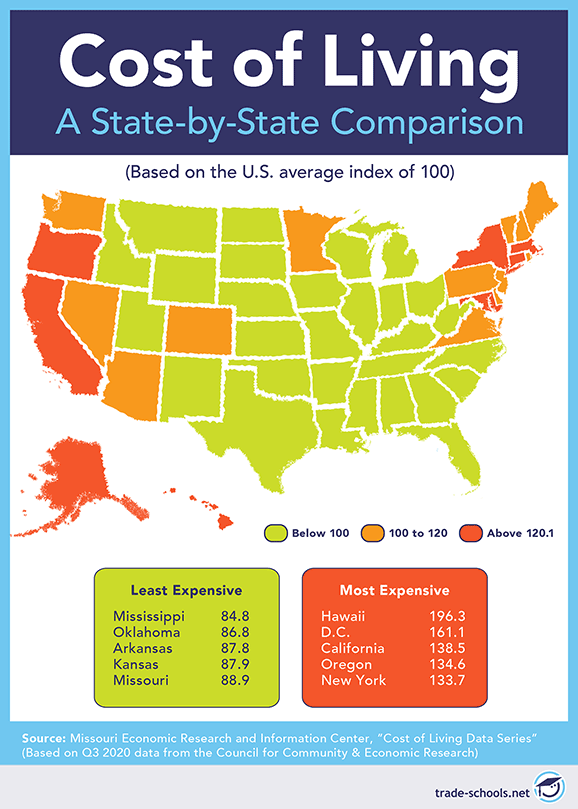The Lowest-Cost-of-Living States and Why They Offer Good Opportunities
Last Updated September 14, 2021
Did you know that people who live in the lowest-cost-of-living states often find it a little easier to achieve some of their biggest goals in life? Those goals may include going to school, securing a good job, owning a home, and contributing to savings and retirement accounts. By living in a state with a lower cost of living, you can stretch your dollars further and afford a more comfortable lifestyle than if you live in a more expensive state.
A lot of people think that the best opportunities are found in the most expensive states and cities. After all, that's why so many people choose to live there, right? Aren't you going to find the best jobs in places like New York City (which was ranked by The Economist Intelligence Unit as the eighth most expensive city in the world in 2020)? Well, not necessarily. The reality is that great opportunities can be found across the country, including some of the cheapest places to live.
For example, what if you found out that you could pursue your dream career in a place like Jackson, Mississippi or Indianapolis, Indiana? You could attend a great post-secondary school, land the job you have always wanted, and start building the life that you desire. And you could have the potential to do all of it more quickly and easily than if you chose to live in a more expensive location. That sounds pretty good, doesn't it?
If you're ready to learn more about your options, then take a look at the following categories to see where the least and most expensive states and cities are ranked:
How Is Cost of Living Determined?
Cost of living is a measure that ranks a location based on factors like the cost of rent, groceries, transportation, utilities, restaurants, and other common living expenses. It also factors in purchasing power, which is an equation that determines the number of goods and services that can be purchased with the average wage in that location.
Historically, New York City has been the most expensive city in the country. It sets the benchmark that all other cities are compared to. NYC is given a cost of living value of 100. Every other city's value is determined based on calculations related to the cost of living factors discussed above.
Determining the cost of living among different states works the same way as it does for cities. However, the states are compared to the national average, which is also valued at 100. As of the third quarter of 2020, Mississippi comes out on top as the lowest-cost-of-living state, according to a ranking of states by the Missouri Economic Research and Information Center (MERIC). Continue reading to discover which states made the top 10. The results may surprise you.

Top 10 Lowest-Cost-of-Living States
When deciding where to go to school or find a job, affordability is frequently an important consideration. Some of the best, low-cost-of-living places in America offer the opportunity for a good job, a nice home for less than $200,000, and a comfortable lifestyle. Many less expensive places to live in the U.S.A. offer opportunities to save money through lower housing, grocery, utility, food, entertainment, and transportation costs.
By choosing to live in one of the states with the lowest cost of living, you could end up with more money in your pocket. Take a look at the list below and see if you can picture yourself living in one of those locations. To help you consider your options, we have included basic information like the strongest industries, fastest-growing jobs, and median home prices for each state. We've also noted the average monthly rent for both a studio and a one-bedroom apartment, which you can compare to the national median gross rents of $934 and $953, respectively (according to U.S. Census Bureau data from 2019).
The list starts with the lowest-cost-of-living state in the country, based on information collected from MERIC for the third quarter of 2020. (The median monthly rent is based on the data from the U.S. Census Bureau. And the median home prices reflect data from 2019.)
1. Mississippi
As a state, Mississippi offers the lowest cost of living in the U.S. But, along with a low living cost, there are many other great reasons to call Mississippi home. You can live a rural lifestyle while still having access to all of the city amenities you want. The state is easy to get around in, traffic congestion is minimal, and there are abundant forests, parks, and wildlife reserves for outdoor enthusiasts.
There also might not be a friendlier place to live. In fact, Mississippi is known as the Hospitality State. It is a great place to get to know your neighbors and belong to a strong community. And it could also be a good place to find a job. There are a wide variety of strong and growing industries to choose from.
- Cost of living: 15.2 percent lower than the national index
- Strongest industries: Advanced manufacturing, agribusiness, energy, healthcare, hospitality, information technology, tourism, warehousing and distribution
- Median monthly rent: $598 (studio); $613 (one-bedroom)
- Median home price: $128,200
Check out some of the fastest-growing jobs in the state. The Mississippi Department of Economic Security projected growth rates are for the decade from 2016 to 2026.
- Home health aide: 27 percent
- Biomedical engineer: 25 percent
- Marketing specialist: 19 percent
- Occupational therapy assistant: 17.7 percent
- Diagnostic medical sonographer: 13.7 percent
- CNC machine programmer: 12.5 percent
- Education, guidance, school, or vocational counselor: 11.6 percent
- Healthcare social worker: 11.3 percent
- Event planner: 7.6 percent
2. Oklahoma
Oklahoma is known as the Sooner State. Maybe that's because the sooner you move there, the better (so that you can start benefiting from one of the cheap places to live in the U.S.A.) With friendly people, delicious food, beautiful lakes, and thriving arts, culture, and music scenes, it's easy to see why this could be a great place for you to live. Even National Geographic Traveler ranked Oklahoma City among the top 20 best cities to visit.
Oklahoma is also a great place to work. The state typically boasts a lower-than-average unemployment rate, and according to a Bureau of Economic Analysis (BEA) report, only eight other states had higher personal income growth from 2017 to 2018. During that time, personal incomes grew by 6.2 percent. You can choose from a variety of interesting industries and jobs, as well as colleges and universities that can help you gain any additional skills that you may need.
- Cost of living: 13.2 percent lower than the national index
- Strongest industries: Aerospace and defense, agriculture, energy, information and financial services, manufacturing
- Median monthly rent: $607 (studio); $641 (one-bedroom)
- Median home price: $147,000
Take a look at some of the fastest-growing careers in Oklahoma and the expected job growth rates from 2020 to 2030.
- Physical therapy aide: 37.8 percent
- Medical and health services managers: 33.1 percent
- Home health aide: 27.8 percent
- Marketing specialist: 24.9 percent
- Substance abuse counselor: 24.6 percent
- Software developers: 24 percent
- Paralegal/legal assistant: 19.8 percent
- Veterinary technician: 19.5 percent
- Plumber: 10.7 percent
- HVAC mechanic: 6.5 percent
3. Arkansas
Affordable, beautiful, friendly, and convenient are just a few ways that Arkansans describe their state. You can take advantage of a laid-back lifestyle and enjoy little to no traffic congestion, even when you are in the city. Outdoor adventurers love the almost endless possibilities for recreational activities, and it's easy to have a weekend getaway to the Gulf Coast, Dallas, Memphis, or Nashville.
You can also find rewarding and meaningful career opportunities across the state. According to the BEA report, Arkansas workers experienced had higher personal income growth than those in the neighboring state of Mississippi from 2017 to 2018. During that time, personal income grew by 4.5 percent. Take a moment to consider what Arkansas can offer you.
- Cost of living: 12.2 percent lower than the national index
- Strongest industries: Aerospace and defense, corporate and shared services, food and beverage production, logistics and distribution
- Median monthly rent: $536 (studio); $576 (one-bedroom)
- Median home price: $136,200
Explore some of the fastest-growing occupations in Arkansas. Their anticipated growth rates are also included for the period from 2018 to 2028.
- Occupational therapy assistant: 39 percent
- Personal care aide: 33.9 percent
- Application software developer: 28.8 percent
- Home health aide: 27.3 percent
- Marketing specialist: 26.6 percent
- Physical therapist assistant: 26.1 percent
- Medical assistant: 25.7 percent
- Massage therapist: 18.8 percent
- Mental health counselor: 17.2 percent
- Mental health and addictions social worker: 17.2 percent
4. Kansas
Kansas is where you will find homegrown hospitality, state pride, and rolling prairies filled with incredible sunflower and wheat fields. Besides being considered a state with a low cost of living, Kansas boasts low unemployment and personal income tax rates. You can also find a number of great training options that can prepare you to join one of the state's strong career sectors.
- Cost of living: 12.1 percent lower than the national index
- Strongest industries: Advanced manufacturing, bioscience, corporate and professional services, energy, logistics and distribution
- Median monthly rent: $651 (studio); $682 (one-bedroom)
- Median home price: $163,200
Here are some of Kansas' top-growing occupations, along with the anticipated growth rates from the Kansas Department of Labor for the 2018-to-2028 period.
- Home health aide: 21.5 percent
- Veterinary technologist/technician: 20.9 percent
- Respiratory therapist: 20.2 percent
- Marketing specialist: 19.3 percent
- Occupational therapy assistant: 15.7 percent
- Mental health counselor: 13.4 percent
- Paralegal/legal assistant: 13.3 percent
- Diagnostic medical sonographer: 13.3 percent
- Computer network support specialist: 12.7 percent
- Fitness trainer: 12.5 percent
5. Missouri
In Missouri, you can choose from city living or rural living with city amenities nearby. Missourians take their barbecue and professional sports teams seriously, but there are many other well-loved state foods and activities to partake in. There are almost countless lakes and beaches to choose from, and you will find a wide selection of classic and craft breweries and wineries.
The state's job market is also stable and growing. MERIC estimates that, from 2018 to 2028, there will be more than 136,000 jobs added to the economy, which represents more than four-percent growth. And if you need to brush up your skills, then you can choose from a number of trade schools, colleges, and universities that can help you prepare for an exciting career.
- Cost of living: 11.1 percent lower than the national index
- Strongest industries: Advanced manufacturing, agricultural technology, bioscience, energy storage, financial services
- Median monthly rent: $687 (studio); $683 (one-bedroom)
- Median home price: $168,000
Following are some of the top jobs in Missouri and their anticipated growth rates (from MERIC) during the 2018-to-2028 period.
- Personal care aide: 33 percent
- Respiratory therapist: 28.4 percent
- Applications software developer: 26.9 percent
- Diagnostic medical sonographer: 23.3 percent
- Phlebotomist: 23.1 percent
- Operations research analyst: 22.5 percent
- CNC machine programmer: 20.9 percent
- Marketing specialist: 17.4 percent
- Web developer/designer: 16.1 percent
- Commercial diver: 13.4 percent
6. Georgia
If you are looking for the states that offer the cheapest cost of living, Georgia may be a good place. It's where you can enjoy distinctive food, abundant green space, and a laid-back Southern lifestyle. It's also a place where you can find a great job in one of the state's strong, diverse industries.
- Cost of living: 10.6 percent lower than the national index
- Strongest industries: Agribusiness and biomass, information technology, advanced manufacturing, transportation and logistics, arts, film, and entertainment
- Median monthly rent: $885 (studio); $985 (one-bedroom)
- Median home price: $202,500
Below are some of the fastest-growing jobs in Georgia, along with the expected job growth rate for 2018 to 2028. Those numbers come from the Georgia Department of Labor.
- Occupational therapy assistant: 59.2 percent
- Veterinary technician/technologist: 43.8 percent
- Interpreter/translator: 40.4 percent
- Information security analyst: 36.1 percent
- CNC machine programmer: 35.8 percent
- Medical assistant: 34.5 percent
- Diagnostic medical sonographer: 30.9 percent
- Phlebotomist: 39.8 percent
- Mental health counselor: 27.9 percent
- Marketing specialist: 27.8 percent
7. Alabama
Along with ranking as one of the states with the lowest cost of living in the U.S., Alabama has a range of industries that are experiencing strong growth. Alabama also has low property taxes and plenty of outdoor recreational opportunities. You can see why this state is an appealing option for many people.
- Cost of living: 10.6 percent lower than the national index
- Strongest industries: Advanced manufacturing, aerospace and aviation, chemical production, information technology, life sciences, logistics and distribution
- Median monthly rent: $562 (studio); $651 (one-bedroom)
- Median home price: $154,000
Below are some of the fastest-growing jobs in Alabama, along with their anticipated growth rates from 2016 to 2026.
- Aircraft mechanic: 38.1 percent
- CNC machine programmer: 35.4 percent
- Applications software developer: 34.1 percent
- Occupational therapy assistant: 31.4 percent
- Operations research analyst: 30.9 percent
- Personal care aide: 29.6 percent
- Phlebotomist: 27.5 percent
- Medical assistant: 24.8 percent
- Industrial machinery mechanic: 21.5 percent
- Diagnostic medical sonographer: 20.9 percent
8. New Mexico
New Mexico may be the affordable place you're looking for. You can find lots to see and do, with world-class festivals, stunning natural wonders, and unique cultural experiences. You can also find a variety of strong industries offering appealing career opportunities.
- Cost of living: 10.4 percent lower than the national index
- Strongest industries: Health services, energy, technology, film, manufacturing, aerospace and defense, agriculture
- Median monthly rent: $575 (studio); $683 (one-bedroom)
- Median home price: $180,900
Discover some of the hottest careers in New Mexico, along with their projected growth rates from the New Mexico Workforce Connection over the 2018-to-2028 period.
- Wind turbine service technician: 108.3 percent
- Personal care aide: 37.8 percent
- Phlebotomist: 26.6 percent
- Operations research analyst: 22.3 percent
- Applications software developer: 20.7 percent
- Veterinary technologist/technician: 20.4 percent
- Massage therapist: 19.4 percent
- Exercise trainer: 16.9 percent
- Substance abuse counselor: 16.2 percent
- Web developer: 14.6 percent
9. Tennessee
Whether you are into music, arts, culture, history, outdoor recreation, or sports, you can find some of the best in Tennessee. It is no wonder that the state and its cities are regularly ranked as the best places to live in the nation. Tennessee offers something for everyone.
The Department of Labor & Workforce Development predicts that from 2018 to 2028, jobs could grow in number by more than seven percent. That amounts to approximately 238,000 new job openings. And if you need to obtain post-secondary training to prepare for one of those career fields, you need not worry. The state has no shortage of training opportunities, either.
- Cost of living: 9.8 percent lower than the national index
- Strongest industries: Advanced manufacturing, healthcare and life sciences, logistics and distribution, corporate headquarters and business services, food and agricultural production
- Median monthly rent: $746 (studio); $780 (one-bedroom)
- Median home price: $191,900
Check out some of the hottest careers in Tennessee, as well as their anticipated growth rates (from the Department of Labor & Workforce Development) during the decade from 2018 to 2028.
- Post-secondary nursing instructor: 30.5 percent
- Physical therapist assistant: 30.1 percent
- Medical assistant: 27.7 percent
- Massage therapist: 23.2 percent
- Dental hygienist: 22.8 percent
- CNC machine programmer: 21.7 percent
- Chemical technician: 18.6 percent
- Computer user support specialist: 16.4 percent
- Accountant: 16.4 percent
- Web developer: 16.1 percent
10. Indiana
Indiana offers all kinds of opportunities to experience arts, culture, dining, sporting events, and fairs. With a number of interstate highways, you can travel around easily, and you can even get away to fun places like Chicago or Nashville for a mini-vacation.
There are also great schools and training programs for those who want to expand their knowledge and skills. You can set yourself up to pursue professional opportunities in many different sectors across the state.
- Cost of living: 9.6 percent lower than the national index
- Strongest industries: Advanced manufacturing, technology, agriculture, life sciences, transportation and logistics
- Median monthly rent: $661 (studio); $685 (one-bedroom)
- Median home price: $156,000
Here are some of the top jobs and projected growth rates in Indiana for the decade from 2018 to 2028.
- Home health aide: 39.1 percent
- Occupational therapy assistant: 38.6 percent
- Software app developer: 28.1 percent
- Operations research analyst: 25.2 percent
- Marketing specialist: 20.8 percent
- Social and human services assistant: 18 percent
- Medical secretary: 16.3 percent
- HVAC mechanic: 13.9 percent
- Plumber: 13.2 percent
- Millwright: 13 percent
All Other States Ranked by Cost of Living
Here's how the remaining states stack up (in descending order), according to MERIC. We've indicated how much higher or lower each state's cost of living index is compared to the national average. We've also included the median monthly rents, based on data from the U.S. Census Bureau.
-
Michigan
- Cost of living: 9.1 percent lower than the national index
- Median monthly rent: $674 (studio); $713 (one-bedroom)
-
Iowa
- Cost of living: 7.9 percent lower than the national index
- Median monthly rent: $568 (studio); $620 (one-bedroom)
-
West Virginia
- Cost of living: 7.9 percent lower than the national index
- Median monthly rent: $539 (studio); $540 (one-bedroom)
-
Texas
- Cost of living: 7.7 percent lower than the national index
- Median monthly rent: $900 (studio); $954 (one-bedroom)
-
Nebraska
- Cost of living: 7.4 percent lower than the national index
- Median monthly rent: $727 (studio); $737 (one-bedroom)
-
Ohio
- Cost of living: 7.1 percent lower than the national index
- Median monthly rent: $614 (studio); $650 (one-bedroom)
-
Louisiana
- Cost of living: 6.6 percent lower than the national index
- Median monthly rent: $710 (studio); $742 (one-bedroom)
-
Kentucky
- Cost of living: 6.2 percent lower than the national index
- Median monthly rent: $574 (studio); $652 (one-bedroom)
-
Idaho
- Cost of living: 5.9 percent lower than the national index
- Median monthly rent: $625 (studio); $681 (one-bedroom)
-
Wyoming
- Cost of living: 4.6 percent lower than the national index
- Median monthly rent: $411 (studio); $611 (one-bedroom)
-
North Carolina
- Cost of living: 4.4 percent lower than the national index
- Median monthly rent: $732 (studio); $853 (one-bedroom)
-
Illinois
- Cost of living: 4.2 percent lower than the national index
- Median monthly rent: $855 (studio); $894 (one-bedroom)
-
South Carolina
- Cost of living: 4.2 percent lower than the national index
- Median monthly rent: $667 (studio); $827 (one-bedroom)
-
Wisconsin
- Cost of living: 3.7 percent lower than the national index
- Median monthly rent: $727 (studio); $706 (one-bedroom)
-
North Dakota
- Cost of living: 3 percent lower than the national index
- Median monthly rent: $658 (studio); $668 (one-bedroom)
-
South Dakota
- Cost of living: 3 percent lower than the national index
- Median monthly rent: $592 (studio); $600 (one-bedroom)
-
Utah
- Cost of living: 2.7 percent lower than the national index
- Median monthly rent: $835 (studio); $922 (one-bedroom)
-
Montana
- Cost of living: 1.2 percent lower than the national index
- Median monthly rent: $590 (studio); $660 (one-bedroom)
-
Florida
- Cost of living: 1 percent lower than the national index
- Median monthly rent: $1,002 (studio); $1,040 (one-bedroom)
-
Minnesota
- Cost of living: 1.2 percent higher than the national index
- Median monthly rent: $831 (studio); $902 (one-bedroom)
-
Arizona
- Cost of living: 1.3 percent higher than the national index
- Median monthly rent: $788 (studio); $889 (one-bedroom)
-
Virginia
- Cost of living: 1.6 percent higher than the national index
- Median monthly rent: $1,264 (studio); $1,153 (one-bedroom)
-
Pennsylvania
- Cost of living: 1.9 percent higher than the national index
- Median monthly rent: $762 (studio); $805 (one-bedroom)
-
Colorado
- Cost of living: 5 percent higher than the national index
- Median monthly rent: $1,068 (studio); $1,196 (one-bedroom)
-
Delaware
- Cost of living: 7.9 percent higher than the national index
- Median monthly rent: $973 (studio); $932 (one-bedroom)
-
New Hampshire
- Cost of living: 8.2 percent higher than the national index
- Median monthly rent: $756 (studio); $900 (one-bedroom)
-
Nevada
- Cost of living: 8.9 percent higher than the national index
- Median monthly rent: $796 (studio); $937 (one-bedroom)
-
Washington
- Cost of living: 11.3 percent higher than the national index
- Median monthly rent: $1,171 (studio); $1,190 (one-bedroom)
-
Vermont
- Cost of living: 16 percent higher than the national index
- Median monthly rent: $794 (studio); $825 (one-bedroom)
-
Maine
- Cost of living: 16.2 percent higher than the national index
- Median monthly rent: $727 (studio); $673 (one-bedroom)
-
New Jersey
- Cost of living: 18.2 percent higher than the national index
- Median monthly rent: $1,059 (studio); $1,181 (one-bedroom)
-
Rhode Island
- Cost of living: 19.4 percent higher than the national index
- Median monthly rent: $798 (studio); $845 (one-bedroom)
-
Connecticut
- Cost of living: 25.1 percent higher than the national index
- Median monthly rent: $846 (studio); $964 (one-bedroom)
-
Alaska
- Cost of living: 28 percent higher than the national index
- Median monthly rent: $806 (studio); $881 (one-bedroom)
-
Maryland
- Cost of living: 28.1 percent higher than the national index
- Median monthly rent: $1,062 (studio); $1,180 (one-bedroom)
-
Massachusetts
- Cost of living: 32.6 percent higher than the national index
- Median monthly rent: $1,100 (studio); $1,086 (one-bedroom)
-
New York
- Cost of living: 33.7 percent higher than the national index
- Median monthly rent: $1,218 (studio); $1,248 (one-bedroom)
-
Oregon
- Cost of living: 34.6 percent higher than the national index
- Median monthly rent: $1,017 (studio); $998 (one-bedroom)
-
California
- Cost of living: 38.5 percent higher than the national index
- Median monthly rent: $1,248 (studio); $1,379 (one-bedroom)
-
District of Columbia
- Cost of living: 61.1 percent higher than the national index
- Median monthly rent: $1,573 (studio); $1,607 (one-bedroom)
-
Hawaii
- Cost of living: 96.3 percent higher than the national index
- Median monthly rent: $1,078 (studio); $1,211 (one-bedroom)
Top 10 Cities With the Lowest Cost of Living
 According to data from Numbeo for mid-2020, El Paso, Texas, tops the list as the city with the lowest cost of living. But there are lots of other great options across the country, from Alabama to Idaho. Why not explore the lowest-cost-of-living cities where you can live, learn, and work—all while stretching your dollars as far as possible? You may find that goals like owning a home and growing your savings or investments become more achievable when you live in one of the lowest cost cities.
According to data from Numbeo for mid-2020, El Paso, Texas, tops the list as the city with the lowest cost of living. But there are lots of other great options across the country, from Alabama to Idaho. Why not explore the lowest-cost-of-living cities where you can live, learn, and work—all while stretching your dollars as far as possible? You may find that goals like owning a home and growing your savings or investments become more achievable when you live in one of the lowest cost cities.
Take a look at the following list and see if any of the locations appeal to you. With each city, you can see how much lower the cost of living index is compared to New York City.
- El Paso, Texas: 42.1 percent lower
- Boise, Idaho: 39.5 percent lower
- Wichita, Kansas: 39.4 percent lower
- Huntsville, Alabama: 38.5 percent lower
- Memphis, Tennessee 37.2 percent lower
- Fresno, California: 37.2 percent lower
- Albuquerque, New Mexico: 36.4 percent lower
- Cincinnati, Ohio: 36 percent lower
- Austin, Texas: 35.6 percent lower
- Little Rock, Arkansas: 35.5 percent lower
When it comes to the largest metro areas in the U.S. (by population size), these regions have the lowest costs of living, according to Q3 2020 data:
- St. Louis, MO: 12.2 percent lower than U.S. average
- Houston, TX 4.2 percent lower
- Tampa, FL: 3.4 percent lower
- Phoenix, AZ 1.6 percent higher
- Atlanta, GA: 1.6 percent higher
- Detroit, MI 4.2 percent higher
- Minneapolis, MN: 4.9 percent higher
- Dallas, TX 8.5 percent higher
- Philadelphia, PA 12.9 percent higher
- Denver, CO: 13.1 percent higher
Top 10 Most Expensive States to Live in Within the U.S.
 Some of the most expensive states to live in probably come as no surprise. For example, Hawaii tops the list due to the islands' high costs for items ranging from fuel and electricity to real estate and food. And because many people want to know where to find the lowest cost of living in California, it probably isn't a shock to learn that the state comes in at number three on the list.
Some of the most expensive states to live in probably come as no surprise. For example, Hawaii tops the list due to the islands' high costs for items ranging from fuel and electricity to real estate and food. And because many people want to know where to find the lowest cost of living in California, it probably isn't a shock to learn that the state comes in at number three on the list.
But keep in mind that when you are looking at the cost of living and determining where to live or go to school, it is important to look at other factors as well. Those include things like job availability and average wages. If you can land a high-paying job in a state or region with a higher cost of living, then the move still might be worth it.
The highest-cost-of-living states and regions all pay median wages that are higher than the national median, which was $19.14 per hour in 2019, according to the Occupational Employment Statistics program. The District of Columbia tops the list with a median wage that is 86.7 percent higher than what is found nationally. So a high-paying job, combined with conservative spending, could mean that a high-cost-of-living state would still be affordable for you. Review the most expensive states below and observe how much higher their median wages are than the national median, as of 2019.
- Hawaii: 11.5 percent higher median wage
- District of Columbia: 86.7 percent higher median wage
- California: 11 percent higher median wage
- Oregon: 3.6 percent higher median wage
- New York: 17.2 percent higher median wage
- Massachusetts: 26.1 percent higher median wage
- Maryland: 15.5 percent higher median wage
- Alaska: 22 percent higher median wage
- Connecticut: 21.9 percent higher median wage
- Rhode Island: 11 percent higher median wage
To break it down further, here are the ten most expensive cities in the nation as of mid-2020. We have also included how much higher or lower their cost of living index is than NYC, based on data from Numbeo.
- New York City, New York
- San Francisco, California: 7.9 percent lower than NYC
- Anchorage, Alaska: 9.2 percent lower
- Oakland, California: 11.3 percent lower
- Boston, Massachusetts: 11.4 percent lower
- Seattle, Washington: 12 percent lower
- Honolulu, Hawaii: 13 percent lower
- Washington, D.C.: 15.3 percent lower
- Miami, Florida: 16.4 percent lower
- Charleston, South Carolina: 16.8 percent lower
Where Will Your Future Take You?
As you explore your opportunities within the lowest-cost-of-living states, you may realize that you can benefit from additional training from a trade school, college, or university. Take your first step today and find out what programs are being offered near you by entering your zip code into the search box below. Don't hold back from achieving your true potential!



